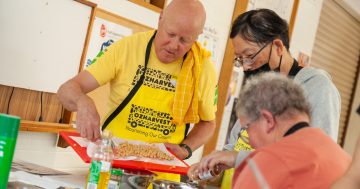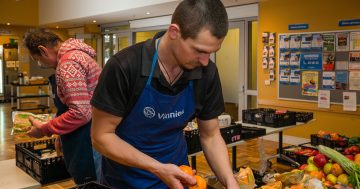
OzHarvest says demand for food is rising constantly in Canberra. Photo: File.
It’s common knowledge in Canberra’s community sector that hunger is on the rise.
In the past few weeks, I’ve spent time at Anglicare in Reid, where they are busier than ever and planning to expand while struggling for the necessary funds.
At the Salvos in Queanbeyan, there’s a queue out the door when they open and hardly room to swing a cat in the storage area. We connected them with a generous donor who provided a commercial fridge, enabling them to store meat, milk, and other perishables again.
Helping ACT has storage areas around the city, wherever it can find shelving and space to stack and pack food, and has expanded its school breakfast program.
Tuckerbox at Hackett and other smaller pantries must limit the amount of fresh veggies they put out for collection because they’d all be gone in minutes.
And OzHarvest, now with a third ACT van, is delivering over 28,000 meals per week to 64 different destinations. They have 22 new local agencies on a waitlist to receive food donations with inquiries steadily increasing.
Their research indicates that demand in Canberra continues to increase, with well over half the agencies they support in the ACT unable to keep up with demand.
So who is hungry in Canberra? And why?

Canberra’s food demand hotspots, according to OzHarvest. Image: OzHarvest
OzHarvest maps demand across all the agencies in all the areas where they deliver. That information provides some interesting indicators.
Demand is strong in the inner city, where many agencies have traditionally been located. There’s also a major hot spot in Queanbeyan, where the likes of the Salvos and St Benedict’s are struggling to meet demand.
But food is being supplied right across the inner north from Ainslie and Hackett, moving out to West Belconnen. There are two large hot spots in Gungahlin and Tuggeranong, a cluster around Woden, and another spot where demand is high around Narrabundah.
No area of the ACT has low demand. Every town centre – and many suburbs – have agencies supplying people who need food, sometimes urgently. The need is literally in your backyard, no matter where you live.
People seeking food in the city centre are often accessing other support services. They may be the “visible homeless”, struggling with multiple problems. They represent a complex, relatively small proportion of the food insecurity problem.
But local agencies tell OzHarvest that 37 per cent of users are approaching them for the first time, the highest rate across Australia of those needing food support. Some of them will be the victims of family and domestic violence – a common causal factor in food insecurity. Many will be partially or fully employed, working two to three jobs to meet their mortgage payments.
Canberra’s food support system is willing and generous but overwhelmed.
It’s a great idea to connect people with social services when they collect food, but how can you do that when you’re so busy ensuring people have food that you can barely keep the shelves stacked?
How do we support the people who are providing food in the first place? How can we ensure that people running street pantries aren’t overwhelmed, that the food supply meets demand, and that there is a safe place to store food?
How do we ensure that food is fresh and safe for consumption? And how do we give hungry people some dignity when many of them feel shame and despair at needing help?
A food insecurity report is pending from the ACT Government. We need practical, workable solutions that coordinate food supply. And every one of us needs to recognise that the problem of hunger is right here in our own backyard. Literally.
Genevieve Jacobs is the CEO of Hands Across Canberra, the ACT’s community foundation.
















